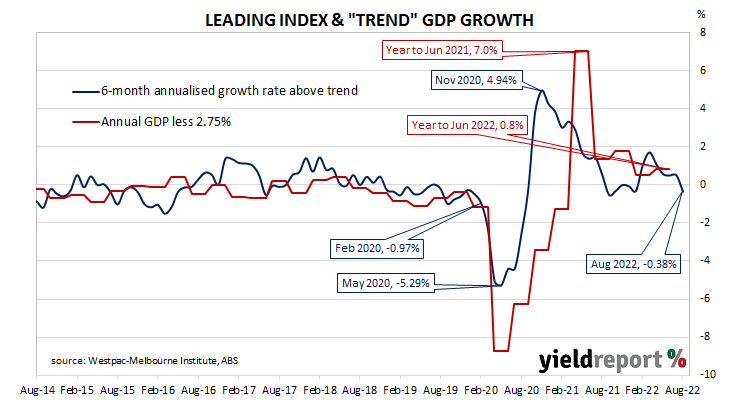Summary:Leading index growth rate down in August; first negative reading since early 2022, “material loss in momentum”; reading implies annual GDP growth of around 2.35%; flatter yield curve, lower commodity prices drives index fall since March.
Westpac and the Melbourne Institute describe their Leading Index as a composite measure which attempts to estimate the likely pace of Australian economic growth in the short-term. After reaching a peak in early 2018, the index trended lower through 2018 and 2019 before plunging to recessionary levels in the second quarter of 2020. Subsequent readings spiked towards the end of 2020 but then trended lower through 2021 and 2022.
The August reading of the six month annualised growth rate of the indicator registered -0.38%, down from July’s figure of 0.49% after it was revised from 0.63%.
“This is the first negative print since the start of the year and the weakest since the delta lockdown hit in 2021,” said Westpac Chief Economist Bill Evans. “The Leading Index is pointing to a material loss in momentum to a below-trend pace.”
Index figures represent rates relative to “trend” GDP growth, which is generally thought to be around 2.75% per annum in Australia. The index is said to lead GDP by “three to nine months into the future” but the highest correlation between the index and actual GDP figures occurs with a three-month lead. The current reading thus represents an annual GDP growth rate of around 2.35% in the middle of the December quarter.
Long-term domestic Treasury bond yields moved a few basis points higher on the day. By the close of business, 10-year and 20-year ACGB yields had both added 3bps to 3.70% and 3.94% respectively. The 3-year yield finished unchanged at 3.45%.
In the cash futures market, expectations of higher rates remained largely unchanged overall. At the end of the day, contracts implied the cash rate would rise from the current rate of 2.31% to 2.685% in October and then increase to 3.07% in November. May 2023 contracts implied a 3.885% cash rate while August 2023 contracts implied 3.795%.
Evans noted the index’s fall since March had been driven by “a sharp narrowing of the yield gap” or, in other words, a flatter yield curve. Lower commodity prices in Aussie dollar terms also played a significant role while lower working hours and slower growth of US industrial output played lesser roles in the index’s fall.


